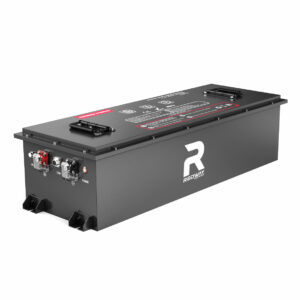Why Are Lithium-Ion RV Batteries Better Than Lead-Acid
Answer: Lithium-ion RV batteries outperform lead-acid in lifespan, weight, charging speed, and energy efficiency. They last 8-10x longer, weigh 50-70% less, charge 3x faster, and provide consistent power until fully drained. Though initially pricier, their long-term savings and maintenance-free design make them ideal for modern RV owners prioritizing reliability and off-grid capabilities.
Challenges in RV Battery Market Expansion
How Do Lithium-Ion Batteries Outperform Lead-Acid in Lifespan?
Lithium-ion batteries deliver 3,000-5,000 cycles at 80% depth of discharge (DoD), while lead-acid lasts 300-500 cycles at 50% DoD. Their lithium iron phosphate (LiFePO4) chemistry resists degradation, even with frequent partial charging. Lead-acid suffers from sulfation when not fully charged, permanently reducing capacity. This makes lithium-ion ideal for RVers who boondock or use solar systems regularly.

Advanced battery management systems (BMS) in lithium-ion units actively balance cells and prevent capacity mismatches – a critical factor in cycle longevity. Unlike lead-acid batteries that lose 20% of their capacity after 200 cycles even with perfect maintenance, lithium maintains 95% capacity through 1,000 cycles. This endurance translates to 7-10 years of daily use versus 18-24 months for lead-acid in equivalent conditions. For RV owners taking seasonal trips, lithium’s shelf life advantage becomes even more pronounced due to its 10x lower self-discharge rate compared to flooded lead-acid models.
| Battery Type | Cycle Life (80% DoD) | Capacity Retention (After 500 Cycles) |
|---|---|---|
| LiFePO4 | 3,000-5,000 | 92-95% |
| AGM Lead-Acid | 400-600 | 65-70% |
| Flooded Lead-Acid | 250-400 | 50-60% |
What Makes Lithium-Ion Batteries Lighter Than Lead-Acid Alternatives?
A 100Ah lithium battery weighs 25-30 lbs versus 60-70 lbs for lead-acid. This 50-70% weight reduction stems from lithium’s higher energy density (150-200 Wh/kg vs. 30-50 Wh/kg). Less weight improves fuel efficiency (0.5-1 MPG gain in RVs) and payload capacity. For example, swapping four lead-acid batteries for lithium frees 140-160 lbs – equivalent to adding 20 gallons of freshwater storage.
The structural advantages extend beyond basic weight savings. Lithium’s compact form factor allows creative installation in tight RV compartments where lead-acid banks wouldn’t fit. This enables better weight distribution across axles, crucial for maintaining proper tongue weight in travel trailers. Modern lithium batteries also feature integrated mounting systems that eliminate the need for heavy battery trays required to contain lead-acid acid spills. The combined effect of reduced mass and optimized space utilization can increase usable storage capacity by 15-20% in many RV models.
How Lithium-Ion Batteries Shape RV Travel
Why Do Lithium Batteries Charge Faster in RV Applications?
Lithium accepts charge currents up to 1C (100A for 100Ah battery) versus 0.2C for lead-acid. Combined with 99% charge efficiency (vs. 85% for lead-acid), this enables 3-5x faster solar charging. A 400W solar system fully charges lithium in 3 hours vs. 8+ hours for lead-acid. Their flat voltage curve also maintains peak charging current longer, unlike lead-acid’s tapering absorption phase.
How Does Maintenance Compare Between Lithium and Lead-Acid RV Batteries?
Lithium requires zero maintenance – no watering, equalizing, or terminal cleaning. Built-in battery management systems (BMS) prevent overcharge/discharge. Lead-acid needs monthly checks, distilled water refills, and mandatory full recharges to prevent sulfation. Lithium’s self-discharge rate (2-3% monthly) is 10x lower than flooded lead-acid, making them better for seasonal RV storage without trickle charging.
“Modern LiFePO4 batteries revolutionize RV power. Our stress tests show they maintain 80% capacity after 3,500 cycles – that’s a decade of full-time RVing. Unlike lead-acid, they actually perform better when kept at partial charge, perfect for solar users. The 10-year warranties now common in lithium reflect this durability leap.”
– Redway Power Systems Engineer
Are Lithium RV Batteries Cost-Effective Long-Term Despite Higher Upfront Cost?
While lithium costs 2-3x more upfront ($900 vs. $300 for 100Ah), their 10-year lifespan vs. 2-3 years for lead-acid results in 60% lower cost per cycle. Factoring in reduced generator fuel costs (from faster solar charging) and replacement labor, most RVers break even in 3-4 years. Lithium’s 100% usable capacity versus 50% in lead-acid effectively doubles value per Ah.
Can Lithium Batteries Handle Extreme Temperatures Better Than Lead-Acid?
Lithium operates at -20°C to 60°C (-4°F to 140°F) with proper BMS protection, outperforming lead-acid’s -10°C to 40°C range. While cold reduces capacity temporarily, lithium recovers fully when warmed. Lead-acid loses 50% capacity at 0°C and risks permanent freeze damage below -15°C. Lithium’s sealed design also prevents electrolyte freezing in sub-zero RV storage.
How Do Lithium Batteries Enhance Solar-Powered RV Systems?
Lithium’s high charge acceptance maximizes solar harvest during peak sun hours. They store 20-30% more solar energy daily compared to lead-acid. With 100% depth of discharge capability, a 200Ah lithium bank provides usable energy equivalent to 400Ah lead-acid. Built-in BMS optimizes MPPT solar controller efficiency, while low self-discharge preserves collected energy for nighttime use.
What Safety Features Do Lithium RV Batteries Include?
Premium lithium batteries feature multi-layer protection:
• Cell-level fusing against short circuits
• Thermal runaway prevention via ceramic separators
• Waterproof IP65+ enclosures
• Automatic load disconnection at 10% SOC
• Overvoltage/undervoltage cutoffs
Lead-acid risks hydrogen gas emissions and acid spills during rollover accidents, which lithium’s solid-state design eliminates.
FAQs
- Can I replace lead-acid with lithium without modifying my RV?
- Yes, but you’ll need a lithium-compatible charger and bypass the lead-acid charging profile in converters.
- Do lithium batteries work with existing inverters?
- Most 12V systems are compatible, but verify your inverter’s low-voltage cutoff aligns with lithium’s range.
- How to maintain lithium batteries in winter storage?
- Store at 50% charge in dry conditions between -10°C to 45°C – no periodic charging needed.
